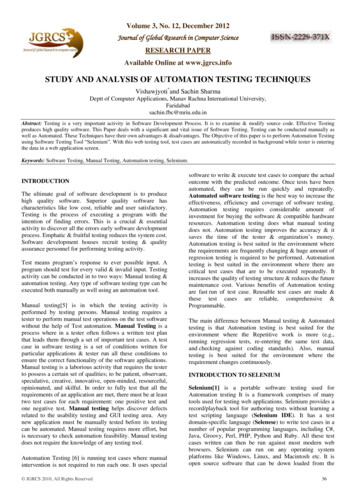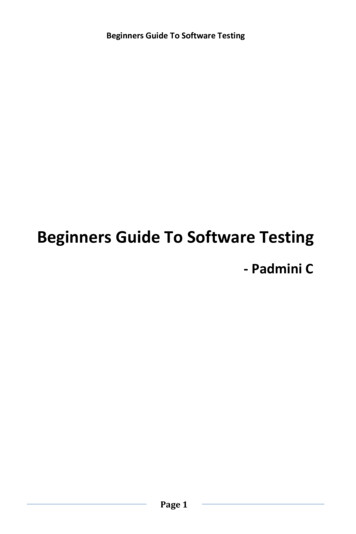
Transcription
Software Testingi
Software TestingAbout the TutorialTesting is the process of evaluating a system or its component(s) with the intent to find whether itsatisfies the specified requirements or not.Testing is executing a system in order to identify any gaps, errors, or missing requirements incontrary to the actual requirements.This tutorial will give you a basic understanding on software testing, its types, methods, levels, andother related terminologies.AudienceThis tutorial is designed for software testing professionals who would like to understand the TestingFramework in detail along with its types, methods, and levels. This tutorial provides enoughingredients to start with the software testing process from where you can take yourself to higherlevels of expertise.PrerequisitesBefore proceeding with this tutorial, you should have a basic understanding of the softwaredevelopment life cycle (SDLC). In addition, you should have a basic understanding of softwareprogramming using any programming language.Copyright & Disclaimer Copyright 2018 by Tutorials Point (I) Pvt. Ltd.All the content and graphics published in this e-book are the property of Tutorials Point (I) Pvt. Ltd.The user of this e-book is prohibited to reuse, retain, copy, distribute or republish any contents or apart of contents of this e-book in any manner without written consent of the publisher.We strive to update the contents of our website and tutorials as timely and as precisely as possible,however, the contents may contain inaccuracies or errors. Tutorials Point (I) Pvt. Ltd. provides noguarantee regarding the accuracy, timeliness or completeness of our website or its contentsincluding this tutorial. If you discover any errors on our website or in this tutorial, please notify us atcontact@tutorialspoint.comii
Software TestingTable of ContentsAbout the Tutorial .1Audience .1Prerequisites .1Copyright & Disclaimer .1Table of Contents .21. SOFTWARE TESTING – OVERVIEW. 5What is Testing? .5Who does Testing? .5When to Start Testing? .5When to Stop Testing? .6Verification & Validation .62. SOFTWARE TESTING – MYTHS. 73. SOFTWARE TESTING – QA, QC, AND TESTING . 9Testing, Quality Assurance, and Quality Control .9Audit and Inspection .9Testing and Debugging .104. SOFTWARE TESTING – ISO STANDARDS . 11ISO/IEC 9126 .11ISO/IEC 9241-11 .11ISO/IEC 25000:2005 .11ISO/IEC 12119 .12Miscellaneous .125. SOFTWARE TESTING – TYPES OF TESTING . 14Manual Testing .14iii
Software TestingAutomation Testing .14What to Automate? .14When to Automate? .15How to Automate? .15Software Testing Tools .156. SOFTWARE TESTING – TESTING METHODS . 17Black-Box Testing.17White-Box Testing .17Grey-Box Testing .18A Comparison of Testing Methods .197. SOFTWARE TESTING – TESTING LEVELS. 20Functional Testing .20Unit Testing .20Integration Testing .21System Testing .21Regression Testing .22Acceptance Testing .22Non-Functional Testing .23Usability Testing .24Security Testing .25Portability Testing .268. SOFTWARE TESTING – DOCUMENTATION. 27Test Plan .27Test Scenario .27Test Case .28Traceability Matrix .29iv
Software Testing9. SOFTWARE TESTING – ESTIMATION TECHNIQUES . 30Functional Point Analysis .30Test Point Analysis.30Mark-II Method .30Miscellaneous .30v
Software Testing1. Software Testing – OverviewWhat is Testing?Testing is the process of evaluating a system or its component(s) with the intent to find whether itsatisfies the specified requirements or not. In simple words, testing is executing a system in order toidentify any gaps, errors, or missing requirements in contrary to the actual requirements.According to ANSI/IEEE 1059 standard, Testing can be defined as - A process of analyzing a softwareitem to detect the differences between existing and required conditions (that is defects/errors/bugs)and to evaluate the features of the software item.Who does Testing?It depends on the process and the associated stakeholders of the project(s). In the IT industry, largecompanies have a team with responsibilities to evaluate the developed software in context of thegiven requirements. Moreover, developers also conduct testing which is called Unit Testing. In mostcases, the following professionals are involved in testing a system within their respective capacities: Software Tester Software Developer Project Lead/Manager End UserDifferent companies have different designations for people who test the software on the basis oftheir experience and knowledge such as Software Tester, Software Quality Assurance Engineer, QAAnalyst, etc.It is not possible to test the software at any time during its cycle. The next two sections state whentesting should be started and when to end it during the SDLC.When to Start Testing?An early start to testing reduces the cost and time to rework and produce error-free software that isdelivered to the client. However in Software Development Life Cycle (SDLC), testing can be startedfrom the Requirements Gathering phase and continued till the deployment of the software.It also depends on the development model that is being used. For example, in the Waterfall model,formal testing is conducted in the testing phase; but in the incremental model, testing is performedat the end of every increment/iteration and the whole application is tested at the end.Testing is done in different forms at every phase of SDLC:1
Software Testing During the requirement gathering phase, the analysis and verification of requirements arealso considered as testing. Reviewing the design in the design phase with the intent to improve the design is alsoconsidered as testing. Testing performed by a developer on completion of the code is also categorized as testing.When to Stop Testing?It is difficult to determine when to stop testing, as testing is a never-ending process and no one canclaim that a software is 100% tested. The following aspects are to be considered for stopping thetesting process: Testing Deadlines Completion of test case execution Completion of functional and code coverage to a certain point Bug rate falls below a certain level and no high-priority bugs are identified Management decisionVerification & ValidationThese two terms are very confusing for most people, who use them interchangeably. The followingtable highlights the differences between verification and validation.S.N.VerificationValidation1Verification addresses the concern: "Areyou building it right?"Validation addresses the concern: "Are youbuilding the right thing?"2Ensures that the software system meetsall the functionality.Ensures that the functionalities meet theintended behavior.3Verification takes place first and includesthe checking for documentation, code,etc.Validation occurs after verification andmainly involves the checking of the overallproduct.4Done by developers.Done by testers.2
Software Testing5It has static activities, as it includescollecting reviews, walkthroughs, andinspections to verify a software.It has dynamic activities, as it includesexecuting the software against therequirements.6It is an objective process and nosubjective decision should be needed toverify a software.It is a subjective process and involvessubjective decisions on how well a softwareworks.3
Software Testing2. Software Testing – MythsGiven below are some of the most common myths about software testing.Myth 1: Testing is Too ExpensiveReality: There is a saying, pay less for testing during software development or pay more formaintenance or correction later. Early testing saves both time and cost in many aspects, howeverreducing the cost without testing may result in improper design of a software application renderingthe product useless.Myth 2: Testing is Time-ConsumingReality: During the SDLC phases, testing is never a time-consuming process. However diagnosing andfixing the errors identified during proper testing is a time-consuming but productive activity.Myth 3: Only Fully Developed Products are TestedReality: No doubt, testing depends on the source code but reviewing requirements and developingtest cases is independent from the developed code. However iterative or incremental approach as adevelopment life cycle model may reduce the dependency of testing on the fully developedsoftware.Myth 4: Complete Testing is PossibleReality: It becomes an issue when a client or tester thinks that complete testing is possible. It ispossible that all paths have been tested by the team but occurrence of complete testing is neverpossible. There might be some scenarios that are never executed by the test team or the clientduring the software development life cycle and may be executed once the project has beendeployed.Myth 5: A Tested Software is Bug-FreeReality: This is a very common myth that the clients, project managers, and the management teambelieves in. No one can claim with absolute certainty that a software application is 100% bug-freeeven if a tester with superb testing skills has tested the application.Myth 6: Missed Defects are due to TestersReality: It is not a correct approach to blame testers for bugs that remain in the application evenafter testing has been performed. This myth relates to Time, Cost, and Requirements changingConstraints. However the test strategy may also result in bugs being missed by the testing team.4
Software TestingMyth 7: Testers are Responsible for Quality of ProductReality: It is a very common misinterpretation that only testers or the testing team should beresponsible for product quality. Testers’ responsibilities include the identification of bugs to thestakeholders and then it is their decision whether they will fix the bug or release the software.Releasing the software at the time puts more pressure on the testers, as they will be blamed for anyerror.Myth 8: Test Automation should be used Wherever Possible to Reduce TimeReality: Yes, it is true that Test Automation reduces the testing time, but it is not possible to starttest automation at any time during software development. Test automaton should be started whenthe software has been manually tested and is stable to some extent. Moreover, test automation cannever be used if requirements keep changing.Myth 9: Anyone can Test a Software ApplicationReality: People outside the IT industry think and even believe that anyone can test a software andtesting is not a creative job. However testers know very well that this is a myth. Thinking alternativescenarios, try to crash a software with the intent to explore potential bugs is not possible for theperson who developed it.Myth 10: A Tester’s Only Task is to Find BugsReality: Finding bugs in a software is the task of the testers, but at the same time, they are domainexperts of the particular software. Developers are only responsible for the specific component orarea that is assigned to them but testers understand the overall workings of the software, what thedependencies are, and the impacts of one module on another module.5
Software TestingEnd of ebook previewIf you liked what you saw Buy it from our store @ https://store.tutorialspoint.com6
Software Testing 4 Given below are some of the most common myths about software testing. Myth 1: Testing is Too Expensive Reality: There is a saying, pay less for testing during software development or pay more for maintenance or correction later. Early










